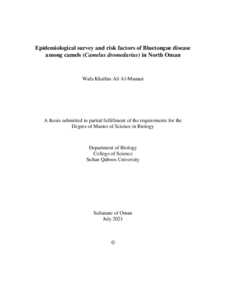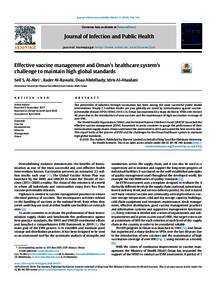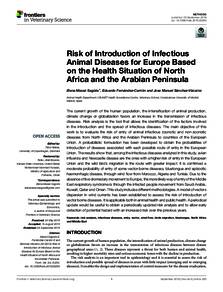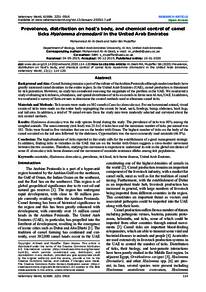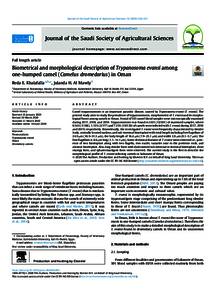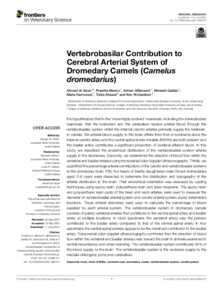Document
Epidemiological survey and risk factors of Bluetongue disease among camels (Camelus dromedarius) in North Oman.
Publisher
Sultan Qaboos University.
Gregorian
2021
Language
English
English abstract
This is the first large-scale study on the seroprevalence of bluetongue disease in camels in
the Sultanate of Oman. Bluetongue (BT) is an infectious, non-contagious, vector-borne
viral disease that affects domestic and wild ruminants, including cattle, buffaloes, camels,
sheep, goats, and deer. The causative agent of the BT is a member of the Orbivirus genus,
and it belongs to the Reoviridae family. This study aimed to estimate the seroprevalence
and potential risk factors of BTV in Omani camels in northern Oman. The study also
aimed to estimate the molecular prevalence of BTV in Omani camels. A cross-sectional
study was conducted in the northern regions of Oman and Sera samples from 439 camels
and out of them 100 blood samples were collected from five governorates from October
2016 to March 2017. Competitive enzyme-linked immunosorbent assay (c-ELISA) was
used for screening serum for BTV antibodies and real-time reverse transcription polymerase chain reaction (RT-qPCR) was used for detecting BTV genomic RNA in
blood. Data of risk factors associated with BTV were collected using a structured
questionnaire. Statistical analysis was performed using the chi-squared test and binary
logistic regression. The overall seroprevalence of BTV was 56.04%. BTV seropositivity
was significantly associated with location, age of camels, sex, participation in events, and
outbreak history whereas, tick infestation in farms and abortion history were not
significant. The highest seroprevalence was in A'Dhahirah 81.08% and the lowest was in
Al Buraimi 40.63%. The finding revealed the BTV seroprevalence was higher in camels
older than 10 years (80%) than camels younger than 4 years old (18.27%) and camels
aged between 4 to 10 years old (65.36%). Further, it was found that BTV seropositivity
was higher in female camels (59.33%) than male camels (32.08%). Notably, camels that
were mixed with small and large ruminants had a seroprevalence of 67.21%, while
camels that were kept alone had a seroprevalence of 40.86%. The seroprevalence of BTV
in camels that had outbreak history was 36.54% and 54.26% in aborted camels. The
overall molecular prevalence in the regions was 26%. The highest active infection
revealed by RT-qPCR was in Ash Sharqiyah (22%), A'Dhahirah (21.05%), and Al
Batinah (27.78%). There was a good agreement between c-ELISA and RT-qPCR (kappa
value = 0.794). The results of the present study showed that the BTV in northern Oman is
enzootic, widely distributed and it is believed BT is an asymptomatic or sub-clinical
disease in camels. Further investigation is required to determine the BTV serotypes that
are circulating in the Sultanate of Oman.
Member of
Resource URL
Arabic abstract
هذه هي أول دراسة واسعة النطاق حول الانتشار المصلي لمرض اللسان الأزرق في الإبل في سلطنة عمان. اللسان
الأزرق (BT ) هو مرض فيروسي غير معٍد وينتقل بالنواقل ويصيب المجترات المنزلية والبرية ، بما في ذلك
الماشية والجاموس والجمال والأغنام والماعز والغزلان. العامل المسبب لـمرض اللسان الأزرق هو عضو في جنس
Orbivirus ، وينتمي إلى عائلة Reoviridae. هدفت هذه الدراسة إلى تقدير الانتشار المصلي وعوامل الخطر
المحتملة لـفيروس اللسان الأزرق في الإبل العمانية في شمال عمان. هدفت الدراسة أيضا إلى تقدير الانتشار الجزيئي
لـفيروس اللسان الأزرق في الإبل العمانية. أجريت دراسة مقطعية في المناطق الشمالية من عمان وعينات سيرا من
439 إبل وتم جمع 100 عينة دم منها من خمس محافظات من أكتوبر 2016 إلى مارس .2017 تم استخدام )-c
ا عن الأجسام المضادة لـ BTV وتم استخدام تفاعل البوليميراز المتسلسل )-RT
ELISA )لفحص المصل بحثً qPCR )للكشف عن الحمض النووي الريبي الجيني BTV في الدم. تم جمع بيانات عوامل الخطر المرتبطة بـ
BTV باستخدام استبيان منظم. تم إجراء التحليل الإحصائي باستخدام اختبار مربع كاي والانحدار اللوجستي الثنائي.
كان معدل الانتشار المصلي الإجمالي لـ BTV 56.04 .٪ ارتبطت الإيجابية المصلية لـ BTV بشكل كبير بالموقع
وعمر الإبل والجنس والمشاركة في الحدث وتاريخ تفشي المرض بينما لم يكن المرض مرتبط بوجود القراد في
الجمال وتاريخ الإجهاض كذلك. وكان أعلى معدل انتشار مصلي في الظاهرة ٪81.08 وأدناها في البريمي .٪40.63
وأظهرت النتائج أن معدل الانتشار المصلي لـ BTV كان أعلى في الإبل الأكبر من 10 سنوات )80٪( من الإبل
الأصغر من 4 سنوات )18.27٪( والإبل التي تتراوح أعمارها بين 4 إلى 10 سنوات )65.36٪(. كما وجد أن
الإيجابية المصلية لـ BTV كانت أعلى في إناث الإبل )59.33٪( من الذكور )32.08٪(. والجدير بالذكر أن الإبل
التي اختلطت مع المجترات الصغيرة والكبيرة كان معدل انتشارها مصليًا بلغ ٪67.21 ، بينما سجلت الإبل التي تم
الاحتفاظ بها بمفردها .٪40.86 وكان معدل الانتشار المصلي لـ BTV في الإبل التي كان لها تاريخ تفشي المرض
٪36.54 و ٪54.26 في الإبل المجهضة. وبلغ معدل الانتشار الجزيئي العام في المناطق .٪26 أعلى نسبة إصابة
فاعلة كشفت عنها نسبة تفاعل البوليميراز المتسلسل كانت في الشرقية ٪22 ، الظاهرة ٪21.05 ، الباطنة .٪27.78
وكان هناك اتفاق جيد بين ELISA-c و PCR-qRT( كانت قيمة .(0.794 kappa وأخيرا أظهرت نتائج الدراسة
الحالية أن BTV في شمال عمان متخ ّصص وراثيًا وموز ًعا على نطاق واسع ويعتقد أن BT مرض عديم األعراض
أو شبه إكلينيكي ولا توجد علامات إكلينيكية على الإبل. لذلك مطلوب مزيد من التحقيق لتحديد الأنماط المصلية
BTV التي يتم تداولها في سلطنة عمان.
الأزرق (BT ) هو مرض فيروسي غير معٍد وينتقل بالنواقل ويصيب المجترات المنزلية والبرية ، بما في ذلك
الماشية والجاموس والجمال والأغنام والماعز والغزلان. العامل المسبب لـمرض اللسان الأزرق هو عضو في جنس
Orbivirus ، وينتمي إلى عائلة Reoviridae. هدفت هذه الدراسة إلى تقدير الانتشار المصلي وعوامل الخطر
المحتملة لـفيروس اللسان الأزرق في الإبل العمانية في شمال عمان. هدفت الدراسة أيضا إلى تقدير الانتشار الجزيئي
لـفيروس اللسان الأزرق في الإبل العمانية. أجريت دراسة مقطعية في المناطق الشمالية من عمان وعينات سيرا من
439 إبل وتم جمع 100 عينة دم منها من خمس محافظات من أكتوبر 2016 إلى مارس .2017 تم استخدام )-c
ا عن الأجسام المضادة لـ BTV وتم استخدام تفاعل البوليميراز المتسلسل )-RT
ELISA )لفحص المصل بحثً qPCR )للكشف عن الحمض النووي الريبي الجيني BTV في الدم. تم جمع بيانات عوامل الخطر المرتبطة بـ
BTV باستخدام استبيان منظم. تم إجراء التحليل الإحصائي باستخدام اختبار مربع كاي والانحدار اللوجستي الثنائي.
كان معدل الانتشار المصلي الإجمالي لـ BTV 56.04 .٪ ارتبطت الإيجابية المصلية لـ BTV بشكل كبير بالموقع
وعمر الإبل والجنس والمشاركة في الحدث وتاريخ تفشي المرض بينما لم يكن المرض مرتبط بوجود القراد في
الجمال وتاريخ الإجهاض كذلك. وكان أعلى معدل انتشار مصلي في الظاهرة ٪81.08 وأدناها في البريمي .٪40.63
وأظهرت النتائج أن معدل الانتشار المصلي لـ BTV كان أعلى في الإبل الأكبر من 10 سنوات )80٪( من الإبل
الأصغر من 4 سنوات )18.27٪( والإبل التي تتراوح أعمارها بين 4 إلى 10 سنوات )65.36٪(. كما وجد أن
الإيجابية المصلية لـ BTV كانت أعلى في إناث الإبل )59.33٪( من الذكور )32.08٪(. والجدير بالذكر أن الإبل
التي اختلطت مع المجترات الصغيرة والكبيرة كان معدل انتشارها مصليًا بلغ ٪67.21 ، بينما سجلت الإبل التي تم
الاحتفاظ بها بمفردها .٪40.86 وكان معدل الانتشار المصلي لـ BTV في الإبل التي كان لها تاريخ تفشي المرض
٪36.54 و ٪54.26 في الإبل المجهضة. وبلغ معدل الانتشار الجزيئي العام في المناطق .٪26 أعلى نسبة إصابة
فاعلة كشفت عنها نسبة تفاعل البوليميراز المتسلسل كانت في الشرقية ٪22 ، الظاهرة ٪21.05 ، الباطنة .٪27.78
وكان هناك اتفاق جيد بين ELISA-c و PCR-qRT( كانت قيمة .(0.794 kappa وأخيرا أظهرت نتائج الدراسة
الحالية أن BTV في شمال عمان متخ ّصص وراثيًا وموز ًعا على نطاق واسع ويعتقد أن BT مرض عديم األعراض
أو شبه إكلينيكي ولا توجد علامات إكلينيكية على الإبل. لذلك مطلوب مزيد من التحقيق لتحديد الأنماط المصلية
BTV التي يتم تداولها في سلطنة عمان.
Category
Theses and Dissertations

